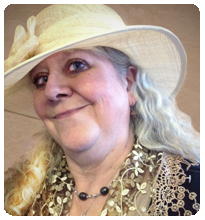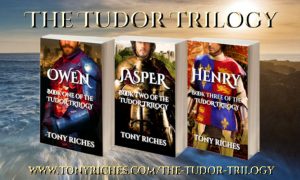Three of my very favourite historical novels – The Pendragon’s Banner Trilogy – were written by the talented Helen Hollick. In this post, Helen tells us how she became an author, and why she started writing about a legendary king many say never existed. JGH

WHY KING ARTHUR FOR HISTORICAL FICTION?
HE’S ONLY A MYTH, ISN’T HE?
By Helen Hollick
A long while ago, in a public library far, far away . . . (The library was in a north-east London suburb, and it must have been the mid-1970s, so yes, a long time ago.) I’d started work as a library assistant, straight from leaving school aged 16. I’d told my school career interviewer that I wanted to be a journalist – I didn’t, I wanted to be an author, but I thought that authors were clever people who went to college and university, so I plumped for journalist. My education was somewhat poor and sketchy. This was in the days when the intelligent kids went to grammar school the rest of us were passed on to secondary level, with us girls expected to become shop assistants, hairdressers and housewives. We didn’t even do science until my second year, and even that was quite basic. I did, however, have a very good English teacher, who must have seen some sort of potential in me because she often gave me extra help and advice with my essays. This careers talk was useless. “A journalist? Don’t be silly Helen, you can’t type!”
Nothing about whether my English was good enough, nothing about the fact that I was so shy I’d have made a hopeless journalist – and for the record, all these years later and about 20 books published, I still only use two fingers on a keyboard.
A job in the local library was suggested, thus, on 4th August, 1969, I found myself in South Chingford Library. I rather enjoyed it because of the access to all those books. I had been an outcast at school because I was always either reading or writing. I’d started scribbling stories when I was about twelve, pony stories because I desperately wanted a pony, so made up a fictional one.
By the time I was 18 I was attempting to write fantasy and science fiction, then one day I picked up a book called The Crystal Cave by Mary Stewart, about Merlin and the young King Arthur. Set in post-Roman Britain it is fantasy, but with a huge dose of believable reality. A cracking good story, but what inspired me was Ms Stewart’s author’s note where she explained that if Arthur had existed (I stress the if!) he would have been a war lord in the late 400s to early 500s, between the going of the Romans and the coming of the Anglo-Saxons, a period of upheaval and chaos. If Arthur had been real, she went on to say, he would not have lived during the 12th-13th centuries, post-Norman Conquest Medieval knights in armour period, because if he had, there would be indisputable evidence to prove it. Nothing has ever been discovered.
This concept of a post-Roman setting intrigued me. Working in the library meant I had access to unlimited research books. I started studying 5th and 6th century Britain – and the matter of Arthur.
One thing I already knew: I had no liking whatsoever for the common Arthurian legends, all that galivanting off in search of the Holy Grail, Lancelot and Guinevere’s unfaithfulness. I realise, now, that I didn’t like these stories because they had no fact behind them, no link to historical reality. Whereas setting Arthur in the earlier period and cutting out all the Norman myth and propaganda left a possibility for something that verged on the plausible.
I searched for other Arthurian fiction: the rest of Mary Stewart’s Crystal Cave/Hollow Hills series for a start, then Rosemary Sutcliff’s wonderful Roman-based novels. (Oh, if only I could write like Rosemary Sutcliff!)
I found The Mists of Avalon. The author Marion Zimmer Bradley has now been discredited for child abuse, which, in hindsight, might explain some of the uncomfortable content of her novel, but even so, this is the only book I have given up reading in utter exasperation. Her Guinevere was such a useless wimp. I threw the book across the room, exclaiming about her character: “Pull yourself together, you silly woman!”
Guinevere, I was certain should be a strong, feisty character, so I decided to abandon my attempts to write a science fiction novel and try something about Arthur and Gwenhwyfar, as I called her – the Welsh spelling.
I researched more of post-Roman Britian and the early history of the Anglo-Saxon/Jute migrations. I emersed myself in the non-fiction books by Geoffrey Ashe and in the end took ten years to write what eventually turned out to be the first two books of my trilogy. The Kingmaking and Pendragon’s Banner were accepted for publication by William Heinemann (now Random House UK) in April 1993, one week after my 40th birthday.
The Trilogy is historical fiction, I cannot claim fact, for a start it is unlikely that ‘Arthur’ ever existed, but I’ve drawn on plausible possibility. There might have been someone who was the idea behind the later, Norman Arthurian stories of courtly romance and the compulsion to join the religious Crusades. Geoffrey Ashe suggested a real chap – well documented – called Riothamus, which is a title meaning something like ‘Kingmost’, not a name. He left Greater Britain (‘England’) to fight in Less Britain (Brittany) and fell in battle somewhere near a Burgundian Roman settlement – Avallon.
https://en.wikipedia.org/wiki/Avallon.
Sound familiar?
I made my Arthur a British warlord, with several human-frailty faults, and a determination to fight hard to gain his rightful kingdom – and as hard to keep it.
The love of his life is Gwenhwyfar, the only daughter of Prince Cunedda of Gwynedd. She is everything that Marian Bradley’s Guinevere was not. Her relationship with Arthur is not always plain sailing, as with any strong-minded couple they have their quarrels, but they live for each other and have three sons – mentioned in the Welsh legends. Despite Arthur being unfaithful, she does not have an affair with Lancelot, in fact he does not appear in my Trilogy. Nor any of the knights, apart from Cei and Bedwyr (who are also in the early Welsh legends).
I have no Holy Grail, no turreted castle of Camelot, no magic, no Merlin . . . Instead, I have told my version of the Arthurian legend as a story about a boy who became a man, who became a king, who became the legend.
 Find all Helen’s books on her Amazon Author Page or order from any good bookstore:
Find all Helen’s books on her Amazon Author Page or order from any good bookstore:
https://viewauthor.at/HelenHollick (universal link)
THE PENDRAGON’S BANNER TRILOGY
1) THE KINGMAKING new edition awarded a bronze medal by the Coffee Pot Book Club annual awards 2023
Amazon UK: https://mybook.to/TheKingmaking_Book1
Amazon USA/Canada: https://tinyurl.com/ys44vh49
2) PENDRAGON’S BANNER
3) SHADOW OF THE KING
ABOUT HELEN HOLLICK:
First accepted for traditional publication in 1993, Helen became a USA Today Bestseller with her historical novel, The Forever Queen (titled A Hollow Crown in the UK) with the sequel, Harold the King (US: I Am the Chosen King) being novels that explore the events that led to the Battle of Hastings in 1066. Her Pendragon’s Banner Trilogy is a fifth-century version of the Arthurian legend, and she writes a nautical adventure/fantasy series, The Sea Witch Voyages. She has also branched out into the quick read novella, Cosy Mystery genre with her Jan Christopher Murder Mysteries, set in the 1970s, with the first in the series, A Mirror Murder incorporating her, often hilarious, memories of working as a library assistant.
Her non-fiction books are Pirates: Truth and Tales and Life of a Smuggler. She is currently writing about the ghosts of North Devon for Amberley Press.
Helen lives with her family in an eighteenth-century farmhouse in North Devon with three dogs and two cats, while on the farm there are four showjumper horses, three fat Exmoor ponies, an old Welsh pony, geese, ducks and hens. And a few resident ghosts.
Website: https://helenhollick.net/
Facebook: https://www.facebook.com/helen.hollick
Blog: promoting good authors & good reads: https://ofhistoryandkings.blogspot.com/
Monthly newsletter: Thoughts from a Devonshire Farmhouse subscribe@helenhollick.co.uk



